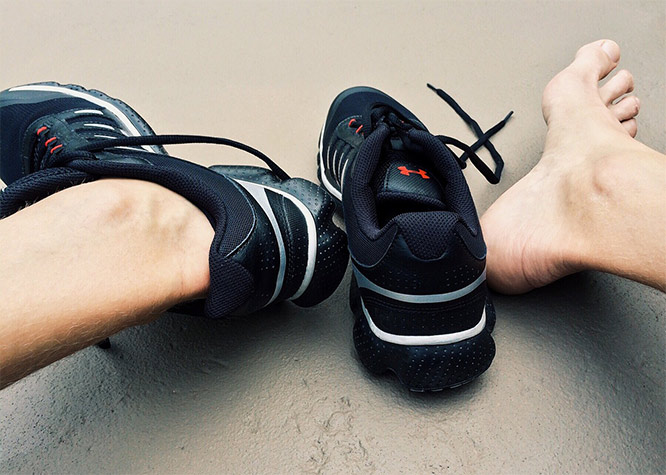
![]()
When you think about it, our feet may be the most underappreciated part of the body. Not only do they have to carry a person’s entire bodyweight, they are responsible for getting us from A to B. Did you know that the average person takes around 7,500-8,000 steps every day, which equates to approximately 150,000 miles in a lifetime?
Feet are a complex but awesome part of the human anatomy. There are no less than 26 bones, 33 joints, 107 ligaments and 19 muscles and tendons in each foot. Not to mention the 8,000 nerves and 250,000 sweat glands.
When it comes to looking after our feet, specialist footcare providers such as podiatrists and chiropodists are at the forefront of diagnosing and treating foot problems. Here are 4 of the most common complaints and what to do about them.
Athlete’s Foot
If you have itchy white patches of skin between your toes and perhaps cracked skin and sore, flaky skin, chances are that these are signs and symptoms of Athlete’s Foot, a common type of fungal infection affecting the feet. It’s also known as tinea pedis, and rather than waiting for it to run its course and disappear (which is unlikely to happen), you need to take remedial action.
Complementary hygiene methods include washing and drying your feet well, particularly between the toes.
Wear fresh cotton socks every day and take your shoes off at home so the air around your feet can circulate.
Avoid wearing shoes that will make your feet hot and sweaty.
Athlete’s Foot is mildly contagious, so if you’re visiting a pool or public changing room, make sure you wear flip-flops.
Ingrown Toenails
Ingrown toenails typically occur as a result of injury, or of simply not cutting your toenails correctly. Unless you cut them straight across, the corner of your toenails can grow down and dig into the skin and beyond. This can be painful and sore to the touch, risking inflammation and infection.
If you have painful toes and are suspecting an ingrown toenail, you should seek medical advice to obtain relief.
A chiropodist will be happy to cut your toenails properly and maintain them in the longer term, which is especially helpful if you are struggling to reach all the way down to your toes.
What you can do to ease the situation is to have a nice warm foot bath, adding some Epsom salts or a dash of antiseptic apple cider vinegar into the bowl. Wear comfy socks and shoes and a toe protector for good measure.
Plantar Fasciitis
A common, painful condition of the heel, plantar fasciitis occurs when the tissue that connects the ball of the foot and the heel becomes inflamed. The pain can take several forms – a stone bruise, sharp dagger, deep throbbing or dull ache. The pain can be excruciating, particularly in the morning, and may ease as you start to move around.
Heel pain can also be triggered by long periods of standing or sitting, and is more common among people who are overweight, have flat feet or high arches, where more stress is placed on the plantar fascia along the bottom of the foot. It also affects long distance runners.
There are many treatments available including wearable orthotics (heel pads and arch supports), rest, exercise and laser therapy.
For serious cases of plantar fasciitis, your chiropodist can use cortisone injections to the foot, achieving improvements to symptoms that can last for weeks or months. Podiatrists from Sussex Foot Centre explain:
Steroids (Methylprednisolone) are given via injection mixed with local anaesthetic (to make the injection more comfortable for you). This would make the area numb for a few hours. You would be reviewed 4 to 6 weeks later and the injection repeated if necessary, to a maximum of three doses per year.
Learn more about plantar fasciitis treatments:
Verrucas
Verruca are a viral infection caused by the human papilloma virus (HPV) and appear as plantar warts – small, rough lumps typically on the soles of the feet. If left untreated, most will eventually disappear of their own accord. Try boosting your immune system by eating a healthy diet and getting enough exercise; it might be enough for your body to get rid of the virus without medication.
Verrucas are technically contagious, so avoid sharing towels, shoes or socks, and wear flip-flops and a waterproof plaster if you go swimming. Try not to scratch it, since open sores can become infected, meaning it will take much longer for them to heal.
Our feet are an important part of our bodies, they support us on a day-to-day basis so taking care of them is also important. Using the methods mentioned above can help to keep them healthy. Various approaches such as keeping your feet clean and dry, your toenails properly cut, and wearing heel supports can help prevent and ease the symptoms of these common foot health problems.
Author Bio
Annie Button is a Portsmouth based writer. Annie likes to share her experiences and knowledge through her articles and has written for a variety online and print publications. When she’s not writing Annie likes cooking healthy new recipes and relaxing with a good book
